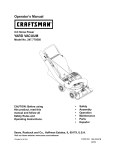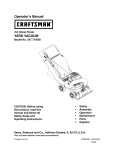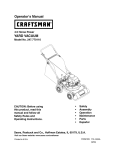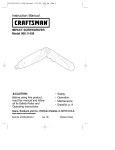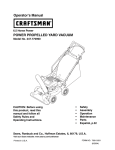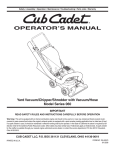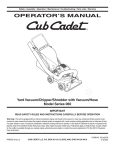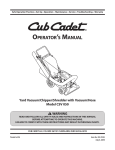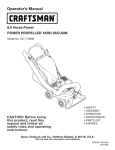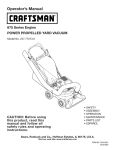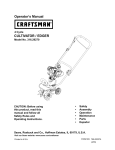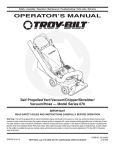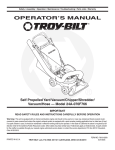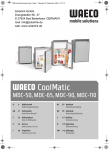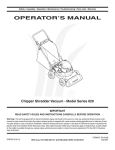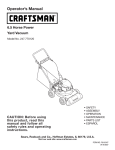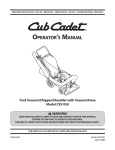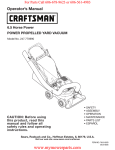Download Cisco Systems 880 Network Router User Manual
Transcript
Operator’s Manual 6.0 Horse Power YARD VACUUM Model No. 247.770550 CAUTION: Before using this product, read this manual and follow all Safety Rules and Operating Instructions. • Safety • ESAssembly • Operation • Maintenance • Parts • Español Sears, Roebuck and Co., Hoffman Estates, IL 60179, U.S.A. Visit our Sears website: www.sears.com/craftsman Printed in U.S.A. FORM NO. 769-00407C.fm (5/04) TABLE OF CONTENTS Content Page Content Page Warranty 2 Service and Adjustments 15 Safety 3 Storage 17 Assembly 6 Troubleshooting 18 Operation 9 Parts List 19 Maintenance 13 Español 23 WARRANTY Limited Warranty on Craftsman Yard Vacuum For one (1) year from the date of purchase, if this Craftsman Equipment is maintained, lubricated, and tuned up according to the instructions to the operator’s manual, Sears will repair or replace free of charge any parts found to be defective in material or workmanship. Warranty service is available free of charge by returning Craftsman equipment to your nearest Sears Service Center. In-home warranty service is available but a trip charge will apply. This Warranty applies only while this product is in the United States. This Warranty does not cover: • Expendable items which become worn during normal use, such as spark plugs, air cleaners, belts, and oil filters. • Tire replacement or repair caused by punctures from outside objects, such as nails, thorns, stumps, or glass. • Repairs necessary because of operator abuse, including but not limited to, damage caused by objects, such as stones or metal debris, oversized stock, impacting objects that bend the frame or crankshaft, or overspeeding the engine. • Repairs necessary because of operator negligence, including but not limited to, electrical and mechanical damage caused by improper storage, failure to use the proper grade and amount of engine oil, or failure to maintain the equipment according to the instructions contained in the operator’s manual. • Engine (fuel system) cleaning or repairs caused by fuel determine to be contaminated or oxidized (stale). In general, fuel should be used within 30 days of its purchase date. • Equipment used for commercial or rental purposes. TO LOCATE THE NEAREST SEARS SERVICE CENTER OR TO SCHEDULE SERVICE, SIMPLY CONTACT SEARS AT 1-800-4-MY-HOME. This warranty gives you specific legal rights and you may also have other rights, which vary from state to state. PRODUCT SPECIFICATION Horsepower: Engine Oil Type Engine Oil Capacity Fuel Capacity: Spark Plug Spark Plug Gap 247.770550 Model Number......................................................... 6.0 Horse Power SAE 30 20 Ounces 1 1/2 Quarts Champion RJ-19LM .030" Serial Number........................................................... Date of Purchase...................................................... Record both serial number and date of purchase and keep in a safe place for future reference. 2 SAFETY WARNING: This symbol points out important safety instructions which, if not followed, could endanger the personal safety and/or property of yourself and others. Read and follow all instructions in this manual before attempting to operate this machine. Failure to comply with these instructions may result in personal injury. When you see this symbol - heed its warning. WARNING: Engine Exhaust, some of its constituents, and certain vehicle components contain or emit chemicals known to State of California to cause cancer and birth defects or other reproductive harm. DANGER: This machine was built to be operated according to the rules for safe operation in this manual. As with any type of power equipment, carelessness or error on the part of the operator can result in serious injury. This machine is capable of amputating hands and feet and throwing objects. Failure to observe the following safety instructions could result in serious injury or death. TRAINING 2. Always wear safety glasses or safety goggles during operation or while performing an adjustment or repair, to protect eyes. Thrown objects which ricochet can cause serious injury to the eyes. 3. Wear sturdy, rough-soled work shoes and closefitting slacks and shirts. Loose fitting clothes or jewelry can be caught in movable parts. Never operate this machine in bare feet or sandals. Wear leather work gloves when feeding material in the chipper chute. 4. Before starting, check all bolts and screws for proper tightness to be sure the machine is in safe working condition. Also, visually inspect machine for any damage at frequent intervals. 5. Maintain or replace safety and instructions labels, as necessary. 6. To avoid personal injury or property damage use extreme care in handling gasoline. Gasoline is extremely flammable and the vapors are explosive. Serious personal injury can occur when gasoline is spilled on yourself or your clothes which can ignite. Wash your skin and change clothes immediately. a. Use only an approved gasoline container. b. Extinguish all cigarettes, cigars, pipes, and other sources of ignition. c. Never fuel machine indoors. d. Never remove gas cap or add while the engine is hot or running. e. Allow engine to cool at least two minutes before refueling. f. Never over fill fuel tank. Fill tank to no more than 1/2 inch below bottom of filler neck to provide space for fuel expansion. g. Replace gasoline cap and tighten securely. h. If gasoline is spilled, wipe it off the engine and equipment. Move machine to another area. Wait 5 minutes before starting the engine. 1. Read, understand, and follow all instructions on the machine and in the manual(s) before attempting to assemble and operate. Keep this manual in a safe place for future and regular reference and for ordering replacement parts. 2. Be familiar with all controls and their proper operation. Know how to stop the machine and disengage them quickly. 3. Never allow children under 16 years old to operate this machine. Children 16 years old and over should read and understand the operation instructions and safety rules in this manual and should be trained and supervised by a parent. 4. Never allow adults to operate this machine without proper instruction. 5. Keep bystanders, helpers, pets, and children at least 75 feet from the machine while it is in operation. Stop machine if anyone enters the area. 6. Never run an engine indoors or in a poorly ventilated area. Engine exhaust contains carbon monoxide, an odorless and deadly gas. 7. Do not put hands and feet near rotating parts or in the feeding chambers and discharge opening. Contact with the rotating impeller can amputate fingers, hands, and feet. 8. Never attempt to unclog either the feed intake or discharge opening, remove or empty vacuum bag, or inspect and repair the machine while the engine is running. Shut the engine off and wait until all moving parts have come to a complete stop. Disconnect the spark plug wire and ground it against the engine. PREPARATION 1. Thoroughly inspect the area where the equipment is to be used. Remove all rocks, bottles, cans, or other foreign objects which could be picked up or thrown and cause personal injury or damage to the machine. 3 9. Never operate without either the inlet nozzle or optional hose attachment properly attached to the machine. Never attempt to attach or change either attachment while the engine is running. 10. Keep all guards, deflectors and safety devices in place and operating properly. 11. Keep your face and body back and to the side of the chipper chute while feeding material into the machine to avoid accidental kickback injuries. 12. Never operate this machine without good visibility or light. Always be sure of your footing and keep a firm hold on the handles. 13. Do not operate this machine on a gravel surface. 14. Do not operate this machine while under the influence of alcohol or drugs. 15. Muffler and engine become hot and can cause a burn. Do not touch. 16. Never pick up or carry machine while the engine is running. i. Never store the machine or fuel container inside where there is an open flame, spark, or pilot light (e.g. furnace, water heater, space heater, clothes dryer, etc.) j. To reduce a fire hazard, keep machine free of grass, leaves, or other debris build-up. Clean up oil fuel spillage and remove any fuel soaked debris. k. Allow machine to cool at least 5 minutes before storing. OPERATION 1. Do not put hands and feet near rotating parts or in the feeding chambers and discharge opening. Contact with the rotating impeller can amputate fingers, hands, and feet. 2. Before starting the machine, make sure the chipper chute, feed intake, and cutting chamber are empty and free of all debris. 3. Thoroughly inspect all material to be shredded and remove any metal, rocks, bottles, cans, or other foreign objects which could cause personal injury or damage to the machine. 4. If the impeller strikes a foreign object or if your machine should start making an unusual noise or vibration, immediately shut the engine off. Allow the impeller to come to a complete stop. Disconnect the spark plug wire, ground it against the engine and perform the following steps: a. Inspect for damage. b. Repair or replace any damaged parts. c. Check for any loose parts and tighten to assure continued safe operation. 5. Do not allow an accumulation of processed material to build up in the discharge area. This can prevent proper discharge and result in kickback of material through the feed opening. 6. Do not attempt to shred or chip material larger than specified on the machine or in this manual. Personal injury or machine damage could result. 7. Never attempt to unclog either the feed intake or discharge opening while the engine is running. Shut the engine off, wait until all moving parts have stopped, disconnect the spark plug wire and ground it against the engine before clearing debris. 8. Never operate without vacuum bag and discharge chute properly attached to the machine. Never empty or change vacuum bag while the engine is running. Rear end of vacuum bag must be kept closed at all times during operation. MAINTENANCE AND STORAGE 1. Never tamper with safety devices. Check their proper operation regularly. 2. Check bolts and screws for proper tightness at frequent intervals to keep the machine in safe working condition. Also, visually inspect machine for any damage and repair, if needed. 3. Before cleaning, repairing, or inspecting, stop the engine and make certain the impeller and all moving parts have stopped. Disconnect the spark plug wire and ground it against the engine to prevent unintended starting. 4. Do not change the engine governor settings or overspeed the engine. The governor controls the maximum safe operating speed of the engine. 5. Maintain or replace safety and instruction labels, as necessary. 6. Follow this manual for safe loading, unloading, transporting, and storage of this machine. 7. Never store the machine or fuel container inside where there is an open flame, spark or pilot light such as a water heater, furnace, clothes dryer, etc. 8. Always refer to the operator’s manual for proper instructions on off-season storage. 9. If the fuel tank has to be drained, do this outdoors. 10. Observe proper disposal laws and regulations for gas, oil, etc. to protect the environment. 4 REPAIR PROTECTION AGREEMENT Congratulations on making a smart purchase.Your new Craftsman® product is designed and manufactured for years of dependable operation. But like all products, it may require repair from time to time. That’s when having a Repair Protection Agreement can save you money and aggravation. Here’s what’s included in the Agreement: Purchase a Repair Protection Agreement now and protect yourself from unexpected hassle and expense. Once you purchase the Agreement, a simple phone call is all that it takes for you to schedule service. You can call anytime day or night, or schedule a service appointment online. Sears has over 12,000 professional repair specialists, who have access to over 4.5 million quality parts and accessories. That’s the kind of professionalism you can count on to help prolong the life of your new purchase for years to come. Purchase your Repair Protection Agreement today! Some limitations and exclusions apply. For prices and additional information call 1-800-827-6655. Sears Installation Service For Sears professional installation of home appliances, garage door openers, water heaters, and other major home items, in the U.S.A. call 1-800-4-MY-HOME® Expert service by our 12,000 professional repair specialists Unlimited service and no charge for parts and labor on all covered repairs Product replacement if your covered product can’t be fixed Discount of 10% from regular price of service and service-related parts not covered by the agreement; also, 10% off regular price of preventive maintenance check Fast help by phone - phone support from a Sears technician on products requiring in-home repair, plus convenient repair scheduling Look For Relevant Emissions Durability Period and Air Index Information On Your Engine Emissions Label Engines that are certified to meet the California Air Resources Board (CARB)Tier 2 Emission Standards must display information regarding the Emissions Durability Period and the Air Index. Sears, Roebuck and Co., U.S.A. makes this information available to the consumer on our emission labels. The Emissions Durability Period describes the number of hours of actual running time for which the engine is certified to be emissions compliant, assuming proper maintenance in accordance with the Operating & Maintenance Instructions. The following categories are used: Moderate: Engine is certified to be emission compliant for 125 hours of actual engine running time. Intermediate: Engine is certified to be emission compliant for 250 hours of actual engine running time. Extended: Engine is certified to be emission compliant for 500 hours of actual engine running time. For example, a typical walk-behind lawn mower is used 20 to 25 hours per year. Therefore, the Emissions Durability Period of an engine with an intermediate rating would equate to 10 to 12 years. The Air Index is a calculated number describing the relative level of emissions for a specific engine family. The lower the Air Index, the cleaner the engine. This information is displayed in graphical form on the emissions label. After July 1, 2000, Look For Emissions Compliance Period On Engine Emissions Compliance Label After July 1, 2000 certain Sears, Roebuck and Co., U.S.A. engines will be certified to meet the United States Environmental Protection Agency (USEPA) Phase 2 emission standards. For Phase 2 certified engines, the Emissions Compliance Period referred to on the Emissions Compliance label indicates the number of operating hours for which the engine has been shown to meet Federal emission requirements. For engines less than 225 cc displacement, Category C = 125 hours, B = 250 hours and A = 500 hours. For engines of 225 cc or more, Category C = 250 hours, B = 500 hours and A = 1000 hours. The displacement engines of Model Series 210000 is 344 cc, 280000 is 465 cc, 310000 engines is 501 cc. This is a generic representation of the emission label typically found on a certified engine. 5 ASSEMBLY NOTE: Reference to right and left hand side of the Yard Vacuum is observed from the operating position. See Figure 1. This Yard Vacuum has been completely assembled at the factory, except for the handle, bag, and blower chute. These parts are shipped loose in the carton. A pair of safety glasses and a 20-oz. bottle of engine oil are also included in the carton. See Figure 1. 20-oz. Bottle of Engine Oil REMOVING UNIT FROM CARTON • • • • Hose Assembly • LOOSE PARTS IN CARTON (See Figure 1) Upper Handle Blower Chute Cut the corners of the carton. Remove all loose parts. Remove packing material. Lift unit from the rear to discard packing material from under unit and roll unit out of carton. Check carton thoroughly for any other loose parts. • • • • • • Wing Nut Rope Guide • Handle Assembly Hose Assembly Bag Blower Chute Safety Glasses (Not Shown) A 20-oz. Bottle of Engine Oil (may be located in bag) Operator’s Manual DISCONNECTING SPARK PLUG Wing Nuts Before proceeding with assembly of your new Yard Vacuum, disconnect the spark plug wire from the spark plug and ground onto the retaining post on the engine. This will prevent accidental starting of the engine. See Figure 2. Bag Lower Handle Retaining Post Wing Nuts Spark Plug Wire Carriage Screw Figure 2 ATTACHING THE HANDLE Figure 1 • IMPORTANT: This unit is shipped without gasoline or oil in the engine. After assembly, see OPERATION section of this manual for proper fuel and engine oil fill-up. 6 Unfold the upper handle until it aligns with lower handle. Make sure the rope guide is on the right side of upper handle. See Figure 1. • • • • Secure the two handles by tightening the upper wing nuts (carriage bolts must be seated properly into the handle). Remove the hairpin clips from the handle brackets and remove the carriage bolts and wing nuts from the lower handle. See Figure 3. Place the bottom holes in lower handle over the pins on handle brackets and secure with hairpin clips. Insert carriage bolts through upper hole in lower handle from the outside and secure with wing nuts. • Snap hose handle into the nozzle handle clip on the lower handle to secure in place and lay hose tubing on side hanger bracket next to chipper chute. Refer to Figure 7. ATTACHING THE BAG Bag Handle Stud Wing Nuts Straps Carriage Bolt Front Tab Hairpin Clip Locking Rod Figure 3 • • Loosen the wing nut that secures the rope guide to the right side of upper handle. Pull the starter rope out of the engine slowly and slip the starter rope into the rope guide. Tighten the wing nut. Stud Figure 5 • Attaching The Hose Assembly • • • • Slide hose adapter of hose assembly into the base adapter located on the left front of the Yard Vacuum. See Figure 4. Pull spring loaded pin out on the base and align pin with the first hole in the hose adapter. Release the pin to lock the hose in place. Connect the hose handle near nozzle end of hose to the handle bracket on the upper handle. Refer to Figure 7. Hose Adapter Spring Loaded Pin Figure 4 • • • Grasp bag handle with one hand and slide locking rod on mounting bracket with other hand toward engine. Use the end of mounting bracket as leverage when sliding the locking rod. See Figure 5. Slip bag over the rim of the discharge opening and release locking rod to secure bag in place. Snap bag clip to the top of the lower handle. Place the lower straps on the bag over the top of lower handle, hooking them on the studs. NOTE: The bag/chute switch button attached to the mounting bracket must be fully depressed by the tip of front tab on bag handle when securing the bag or engine will not start. ATTACHING THE BLOWER CHUTE NOTE: The bag must be removed before installing the blower chute. • Grasp blower chute with one hand and slide locking rod on mounting bracket with other hand toward engine. Use the end of mounting bracket as leverage when sliding the locking rod. See Figure 6. • Slip blower chute over rim of discharge opening and release locking rod to secure chute in place. 7 • Raise the nozzle height to the highest setting when using the blower chute. Refer to nozzle height adjustment in the ADJUSTMENT section. NOTE: The bag/chute switch button attached to the mounting bracket must be fully depressed by the tip of front tab on the blower chute or engine will not start. Blower Chute Front Tab Front Tab Locking Rod Locking Rod Figure 6 8 OPERATION Know Your Yard Vacuum Read this operator’s manual and safety rules before operating your Yard Vacuum. Compare the illustrations below with your equipment to familiarize yourself with the location of various controls and adjustments. Save this manual for future reference. The operation of any Yard Vacuum can result in foreign objects being thrown into the eyes, WEAR YOUR SAFETY GLASSES which can result in severe eye damage. Always wear safety glasses, provided with the Yard Vacuum, for operating this equipment or while performing any adjustments or repairs on it. FORESIGHT IS BETTER THAN NO SIGHT Bag Starter Handle Bag Handle Nozzle Handle Clip Throttle Control Hose Handle Nozzle/Hose Vac Handle Hose Assembly Chipper Chute Spark Plug Wire Blower Chute Hanger Bracket Choke Control Nozzle Nozzle Height Adjustment Lever Figure 7 OPERATING CONTROLS (See Figure 7) Nozzle Height Adjustment Lever Chipper Chute Used to adjust the nozzle ground clearance ranging from 5/8" to 4 1/8". Allows twigs and small branches up to 1 1/2" in diameter to be fed into the impeller for chipping. Nozzle Yard waste such as leaves and pine needles can be vacuumed up through the nozzle for shredding. Throttle Control This lever controls the engine speed and stop function. Through three separate positions on the lever from left to right, the operation is as follows: Bag Collects shredded material fed in through the chipper chute or vacuumed in through the nozzle. Stop Start/ Run Blower Chute When attached to unit, the blower chute is used to blow or scatter yard waste such as leaves, pine needle, or small twigs across yard. Bag Handle Used to grasp bag in order to assist in attaching, removing, and emptying bag. Slow/ Idle Engine Off Choke Control The choke control is used to choke of the carburetor and assist in starting the engine. Starter Handle Used to start the engine. Meets ANSI safety standards Craftsman Yard Vacuums conform to the safety standard of the American National Standards Institute (ANSI). 9 Hose Assembly • Used as an alternative to the nozzle to vacuum yard waste such as leaves or pine needles in hard to reach places. Hose Handle Used to guide hose assembly when vacuuming. • Nozzle/Hose Vac Handle The nozzle/hose vac handle is located on top of the nozzle and it is used to regulate the vacuum between the nozzle and the hose assembly. WARNING: Use extreme care when handling gasoline. Gasoline is extremely flammable and the vapors are explosive. Never fuel machine indoors or while the engine is hot or running. Extinguish cigarettes, cigars, pipes, and other sources of ignition. GAS AND OIL FILL-UP Oil (one 20-oz. bottle shipped with unit) Only use high quality detergent oil rated with API service classification SF, SG, or SH. Select the oil’s SAE viscosity grade according to the expected operating temperature. Follow the chart below. 32°F Colder 5W30 Warmer • SAE 30 Oil Viscosity Chart NOTE: Although multi-viscosity oils (5W30, 10W30, etc.) improve starting in cold weather, they will result in increased oil consumption when used above 32°F. Check your engine oil level more frequently to avoid possible engine damage from running low on oil. Remove oil fill dipstick. With the Yard Vacuum on level ground, use a funnel to fill engine with oil to FULL mark on dipstick. Capacity is approximately 20 oz. Be careful not to overfill. Overfilling will cause the engine to smoke profusely and will result in poor engine performance. The oil bottle packaged with your Yard Vacuum contains 20 oz. of oil. • Check the oil level making certain not to rub the dipstick along the inside walls of the oil fill tube. This would result in a false dipstick reading. Refill to FULL mark on dipstick, if necessary. Replace dipstick and tighten. • Check oil level three times prior to starting engine to be certain you’ve gotten an accurate dipstick reading. Running the engine with too little oil can result in permanent engine damage. Gasoline Remove fuel cap from the fuel tank. Make sure the container from which you will pour the gasoline is clean and free from rust or foreign particles. Never use gasoline that may be stale from long periods of storage in its container. Gasoline that has been sitting for any period longer than four weeks should be considered stale. Check the fuel level periodically to avoid running out of gasoline while operating the Yard Vacuum. If the unit runs out of gas as it is chipping, it may be necessary to unclog the unit before it can be restarted. Refer to SERVICE AND ADJUSTMENT section. TO STOP ENGINE • • Move throttle control lever to STOP or OFF position. Disconnect spark plug wire and ground it to the post to prevent accidental starting while the equipment is unattended. WARNING: When moving throttle control lever, be careful of heated surfaces and sharp edges on muffler guard. • • • • Fill fuel tank with clean, fresh, unleaded regular, unleaded premium or reformulated automotive gasoline only. DO NOT use Ethyl or high octane gasoline. Do not use gasoline containing METHANOL. Replace fuel cap. To avoid engine problems, the fuel system should be emptied before storage for 30 days or longer. Drain the gas tank, start the engine and let it run until the fuel lines and carburetor are empty. Use fresh fuel next season. See STORAGE section for additional information. TO START ENGINE 1. Attach spark plug wire and rubber boot to spark plug. 2. The bag/chute switch button must be fully depressed by the tip of front tab on bag handle or blower chute for engine to start. 3. Make sure bag/chute switch wire is connected to engine and grounded to mounting bracket. 4. Gas tank should be filled 3/4 to full before starting. 5. Move throttle control to START/RUN position. See Figure 8. 6. Move the choke control toward the throttle control to choke the engine’s carburetor. (A warm engine may not require choking.) See Figure 8. 10 Throttle Control Buttons Inner Flap Bag Clip Bag Handle Outer Flap Choke Control Strap Figure 8 7. Standing behind the unit, grasp starter handle and pull rope out until you feel a drag. 8. Pull the rope with a rapid, continuous, full arm stroke. Keep a firm grip on the starter handle. Let the rope rewind slowly. Figure 9 TO REMOVE BLOWER CHUTE 9. Repeat, if necessary, until engine starts. When engine starts, move choke control gradually away from the throttle control. • Grasp blower chute with one hand and pull lock rod on mounting bracket with other hand toward engine to release. Refer to Figure 6. Remove blower chute from over the rim of the discharge opening. 10. If engine falters, move choke control back toward the throttle control and repeat steps 7-9. • 11. ALWAYS keep the throttle control in the START/ RUN position when operating the Yard Vacuum. Using the Nozzle Vacuum TO EMPTY BAG Place nozzle/hose vac handle in the top position on the nozzle to vacuum through nozzle. See Figure 10. • • • • • • • • Unhook bag straps from the lower handle and unsnap bag clip from top of the lower handle. See Figure 9. Grasp bag handle with one hand and pull lock rod on mounting bracket with other hand toward engine to release. Remove bag from over the rim of the discharge opening. Refer to Figure 5. Twist the two buttons on the back of the bag to unlock and empty contents. See Figure 9. Hold bag handle and bag clip while emptying the contents. Compress bag opening and fold inner flap over opening. Fold outer flap over inner flap and insert buttons on the bag through metal outlets. Twist the buttons to lock bag. Nozzle/Hose Vac Handle (Top Position) Spring Loaded Pin (First Hole) Figure 10 • • 11 The spring loaded pin must be in the first hole of the hose adapter to operate the nozzle vac. Place both hands on top of upper handle to push unit over yard waste. Nozzle Height Adjustment Yard waste such as leaves and pine needles can be vacuumed up through the nozzle for shredding. After material has been shredded by the flail blades on the impeller assembly, it will be discharged into catcher bag or through blower chute. Do not attempt to shred or chip any material other than vegetation found in a normal yard (i.e. branches, leaves, twigs, etc.) Avoid fibrous plants such as tomato vines until they are thoroughly dried out. Materials such as stalks or heavy branches up to 1 1/2” in diameter may be fed into the chipper chute. The nozzle can be adjusted to any six positions, ranging from 5/8” to 4 1/8” ground clearance. The nozzle height has to be adjusted according to the conditions. Move the height adjustment levers forward or backward to adjust the nozzle upwards or downwards. See Figure 12. NOTE: In general, raise the nozzle height to vacuum a thick layer of leaves or to operate with the blower chute and lower the nozzle height for smoother surfaces. WARNING: Do not attempt to shred, chip, or vacuum any material larger than specified on the machine or in this manual. Personal injury or damage to the machine could result. IMPORTANT: The flail screen is located inside the housing in the discharge area. If the flail screen becomes clogged, remove and clean as instructed in Service and ADJUSTMENTS on page 15 . For best performance, it is also important to keep the chipper blade sharp. WARNING: Do not at any time make any adjustments without first stopping engine and disconnecting spark plug wire. Using the Hose Assembly • • • Nozzle Height Adjustment Lever Nozzle Figure 12 Place nozzle/hose vac handle in the bottom position on the nozzle to redirect vacuum to the hose assembly. See Figure 11. The spring loaded pin must be in the second hole of the hose adapter to operate the hose assembly. Unhook the hose from upper handle bracket and grasp the hose handle to guide while vacuuming yard waste such as leaves or pine needles in hard to reach places. Nozzle/Hose Vac Handle (Bottom Position) Spring Loaded Pin (Second Hole) Figure 11 12 PRODUCT MAINTENANCE SCHEDULE Be for ee ac hu se Af ter ea ch us e Fir st 5h ou rs Ev er y2 5h ou rs Ev er y5 0h ou rs Be for es tor ag e MAINTENANCE Lubrication Clean equipment ENGINE Check engine oil Change engine oil Service air cleaner Service spark plug Service muffler Clean engine GENERAL RECOMMENDATIONS CLEAN EQUIPMENT • • • • • • Always observe safety rules when performing any maintenance. The warranty on this Yard Vacuum does not cover items that have been subjected to operator abuse or negligence. To receive full value from the warranty, operator must maintain the equipment as instructed in this manual. Some adjustments will need to be made periodically to maintain your equipment properly. Follow the maintenance schedule. Periodically check all fasteners and make sure they are tight. • • NOTE: Cleaning with a forceful spray of water is not recommended as it could contaminate the fuel system. CHECK ENGINE OIL WARNING: Always stop the engine and disconnect and ground the spark plug wire before performing any maintenance or adjustments. • • • LUBRICATION • • • Clean the Yard Vacuum thoroughly after each use. Wash the bag periodically with water. Allow to dry thoroughly in the shade. If the flail screen becomes clogged, remove and clean as instructed in the SERVICE AND ADJUSTMENT section. Remove oil fill dipstick. Check oil level on dipstick. Level should be at FULL mark. Replace dipstick and tighten. CHANGE ENGINE OIL Wheels- Place a few drops of SAE 30 oil on each shoulder screw once a season. Refer to Figure 7. Nozzle height adjustment levers- Lubricate nozzle height adjustment levers with light oil. Refer to Figure 7. Locking Rod- Lubricate the lock rod and compression springs which attach to the mounting bracket. Refer to Figure 5. • • • 13 Only use high quality detergent oil rated with API service classification SF, SG, or SH. Select the oil’s SAE viscosity grade according to the expected operating temperature. Refer to operation section for viscosity chart. Stop engine and wait several minutes before checking oil level. With engine on level ground, the oil must be to FULL mark on dipstick. Change engine oil after the first five hours of operation, and every twenty-five hours thereafter. TO DRAIN OIL SERVICE SPARK PLUG Drain oil while engine is warm. Follow the instructions given below. • • • • • • Drain the gas tank, start the engine and let it run until the fuel line and carburetor are empty. Remove oil fill dipstick. Tip unit on its side to drain through the oil fill tube. When engine is drained of all oil, refill with approximately 20 oz. of fresh oil. Refer to Gas And Oil Fill-up in OPERATION section. Replace dipstick. Clean the spark plug and reset the gap to.030" at least once a season or every 50 hours of operation. See Figure 13. Spark plug replacement is recommended at the start of each season. Refer to engine parts list for correct spark plug type. NOTE: Do not sandblast spark plug. Spark plug should be cleaned by scraping or wire brushing and washing with a commercial solvent. .030" Feeler Gauge SERVICE AIR CLEANER The air cleaner prevents damaging dirt, dust, etc., from entering the carburetor and being forced into the engine and is important to engine life and performance. The air cleaner consists of a foam filter. Never run the engine without an air cleaner completely assembled. Spark Plug Figure 13 To Service Air Cleaner: • • • • • • Remove foam filter from plastic housing on top of engine. Wash in water and detergent solution, and squeeze (do not twist) until all dirt is removed. Rinse thoroughly in clear water. Wrap in a clean cloth and squeeze (do not twist) until completely dry, or allow to air dry. Saturate with engine oil and squeeze to distribute oil and remove excess oil. Replace foam filter in plastic housing SERVICE MUFFLER • • Inspect muffler periodically, and replace if necessary. If your engine is equipped with a spark arrester screen assembly, remove after every 50 hours of use for cleaning and inspection. Replace if damaged. WARNING: Do not operate the Yard Vacuum without a muffler or tamper with the exhaust system. Damaged mufflers or spark arresters could create a fire hazard. NOTE: If the foam filter is torn or damaged in any way, replace it. WARNING: Temperature of muffler and nearby areas may exceed 150o F (65oC). Avoid these areas. CLEAN ENGINE • • 14 Clean engine by removing dirt and debris with a cloth or brush. Frequently remove grass clippings, dirt, and debris from cooling fins, air intake screen, levers, and linkage. This will help ensure adequate cooling and engine speed. SERVICE AND ADJUSTMENTS WARNING: Do not attempt to alter the engine speed by tampering with the engine’s governor linkage. Doing so could result in serious personal injury and damage to the engine. The engine RPM has been set at the factory. WARNING: Do not at any time make any adjustment to the unit without first stopping engine and disconnecting spark plug wire. Nozzle Height Adjustment The nozzle can be adjusted to any six positions, ranging from 5/8” to 4 1/8” ground clearance. The nozzle height has to be adjusted according to the conditions. Move the height adjustment levers forward or backward to adjust the nozzle upwards or downwards. See Figure 14. REMOVING THE FLAIL SCREEN NOTE: In general, raise the nozzle height to vacuum a thick layer of leaves or to operate with the blower chute and lower the nozzle height for smoother surfaces. • If the discharge area becomes clogged, remove the flail screen and clean area as follows. • • Stop the engine. Make certain the chipper shredder vacuum has come to a complete stop. Disconnect and ground the spark plug wire before unclogging the discharge chute. Remove the vacuum bag or blower chute from the unit as instructed in the OPERATION section to obtain access to flail screen. See Figure 15. Hex Screw Flange Flail Screen Lock Nut REAR VIEW Nozzle Height Adjustment Lever Nozzle Figure 15 • Figure 14 Remove self-tapping screw on right side of unit that attaches to the flail screen. See Figure 16. CARBURETOR ADJUSTMENT WARNING: If any adjustments (e.g. carburetor) are made to the engine while the engine is running, keep clear of all moving parts. Be careful of heated surfaces and muffler. The carburetor has been pre-set at the factory and should not require adjustment. If your engine does not operate properly due to suspected carburetor problems, take your Yard Vacuum to a Sears Service Center for repair and adjustment. Remove Self-Tapping Screw Figure 16 ENGINE SPEED • The engine speed on your Yard Vacuum has been set at the factory. Do not attempt to increase the engine RPM. If you think that the engine is running too fast or too slow, take your Yard Vacuum to the nearest Sears Service Center for repair and adjustment. • 15 Remove hex screw on top of rear housing near mounting bracket and the flange lock nut that secures flail screen. See Figure 15. Remove and clean the screen by scraping or washing with water. Reinstall the screen. SHARPENING OR REPLACING CHIPPER BLADE • Because the engine on this unit has a tapered crankshaft, a special impeller removal tool (part number 753-0900) is required to remove the impeller assembly. For further assistance, contact your Sears Service Center. • NOTE: When tipping the unit, empty the fuel tank and keep engine spark plug side up. Chipper Blade • • Remove flange lock nut that secures flail screen to the lower housing. The flail screen does not have to be removed. Refer to Figure 15. Remove the hex bolt, lock washer, and flat washer that secure the impeller assembly to the crankshaft. See Figure 19. Upper Housing Impeller Assembly Disconnect and ground the spark plug wire. Remove the front hubcaps, flange lock nuts, front wheels, and wave washers that attach to the pivot arm assemblies. See Figure 17. Hex Bolt Lock Washer Flat Washer Front Support Brace & Lock Nut Bell Washer Flail Blade Wave Washer Hubcap BOTTOM VIEW Figure 19 Pivot Arm Assembly • Thrust Washer Shoulder Screw Flange Lock Nut Figure 17 • • • Remove the shoulder screws, thrust washers, and bell washers that go through the pivot arms to the front support brace. The front support brace and lock nut can be removed at this time as well. Remove the three screws on the upper housing that secure the nozzle cover and the nine screws that secure the lower housing to the upper housing. See Figure 18. • • • • Apply lubricant to the threads of impeller removal tool and then thread the tool into the crankshaft. Stop when the impeller assembly can move on the crankshaft. Remove the impeller assembly from the crankshaft. Unthread the impeller removal tool from the impeller assembly. Remove the chipper blade using a 3/16" allen wrench on the outside of the blade and 1/2" wrench on the underside of impeller assembly. Replace or sharpen chipper blade. When sharpening blade, protect hands by using gloves and follow the original angle of grind. Reassemble by performing the previous steps in reverse order. • Tighten blade screws to 210 - 250 in-lbs. • Tighten impeller bolt to 375 - 425 in-lbs. Housing Screws NOTE: Make certain chipper blade is reassembled with the sharp edge facing upward. See Figure 20. Chipper Blade Flail Blade Impeller Assembly Lower Housing Screws Nozzle Screws Figure 18 Figure 20 16 STORAGE NOTE: Fuel stabilizer is an acceptable alternative in minimizing the formation of fuel gum deposits during storage. Prepare your Craftsman Yard Vacuum for storage at the end of the season or if the unit will not be used for 30 days or longer. A yearly check-up by your local Sears Service Center is a good way to ensure that the unit runs properly next season. • Add stabilizer to gasoline in fuel tank or storage container. • Always follow the mix ratio found on stabilizer container. • Run engine at least 10 minutes after adding stabilizer to allow the stabilizer to reach the carburetor. • Do not drain the gas tank and carburetor if using fuel stabilizer. Drain all the oil from the crankcase (this should be done after the engine has been operated and is still warm) and refill the crankcase with fresh oil. If you have drained the fuel tank, protect the inside of the engine as follows: Yard Vacuum • • • • Clean the equipment thoroughly. Wipe equipment with an oiled rag to prevent rust. Use a light oil or silicone to wipe. Service the engine following instructions below. Store unit in a clean, dry area. Do not store next to corrosive materials such as fertilizer. Engine IMPORTANT: It is important to prevent gum deposits from forming in essential fuel system parts such as the carburetor, fuel filter, fuel hose, or tank during storage. Also, alcohol blended fuels (called gasohol or using ethanol or methanol) can attract moisture which leads to separation and formation of acids during storage. Acidic gas can damage the fuel system of an engine while in storage. • • Other • To avoid engine problems, the fuel system should be emptied before storage of 30 days or longer. Follow these instruction: • • • • Remove spark plug, pour approximately 1/2 ounce (approximately one tablespoon) of engine oil into cylinder and crank slowly to distribute oil. Replace spark plug. • Drain the fuel tank. Start the engine and let it run until the fuel lines and carburetor are empty. Drain carburetor. Never use engine or carburetor cleaner products in the fuel tank or permanent damage may occur. • Do not store gasoline from one season to another. Replace the gasoline can if it starts to rust. Rust and/or dirt in the gasoline will cause problems. Store unit in a clean, dry area. Do not store next to corrosive materials, such as fertilizer. NOTE: If storing in an unventilated or metal storage shed, be certain to rustproof the equipment by coating with a light oil or silicone. 17 TROUBLESHOOTING Problem Possible Cause(s) Corrective Action Engine fails to start 1. Fuel tank empty or stale fuel. 1. Fill tank with clean, fresh gasoline. Fuel will not last over thirty days unless a fuel stabilizer is added. 2. Connect wire to spark plug. 3. Obstruction lodged in impeller. Disconnect spark plug wire and remove lodged object. 4. Move CHOKE to ON position. 5. Clean, adjust gap or replace. 6. Safety switch must be depressed by the front tab on the bag handle when securing the bag. 7. Connect safety switch wire to engine connector and ground to mounting bracket. 2. Spark plug wire disconnected. 3. Cannot pull recoil cord. 4. Choke not in ON position. 5. Faulty spark plug. 6. Safety switch not depressed. 7. Safety switch wire is not connected to engine or not properly grounded. Loss of power; operation erratic 1. Connect and tighten spark plug wire. 2. Move choke lever to OFF position. 3. Clean fuel line; fill tank with clean fresh gasoline. Fuel will not last over thirty days unless a fuel stabilizer is used. 4. Disconnect fuel line at carburetor to drain fuel tank. Refill with fresh fuel. 5. Contact your Sears Service Center. 6. Always run engine at full throttle. 1. Spark plug wire loose. 2. Unit running on CHOKE. 3. Blocked fuel line or stale fuel. 4. Water or dirt in fuel system. 5. Carburetor out of adjustment. 6. Low engine RPM. Too much vibration 1. Loose parts or damaged impeller. 1. Stop engine immediately and disconnect spark plug wire. Have unit serviced by a Sears Service Center. Engine overheats 1. Carburetor not adjusted 2. Engine oil level low 1. Contact your Sears Service Center. 2. Fill crankcase with proper selection of oil. Unit does not discharge 1. Discharge chute clogged. 1. Stop engine immediately and disconnect spark plug wire. Clean flail screen and inside of discharge opening. See Maintenance section of this manual. 2. Stop engine immediately and disconnect spark plug wire. Remove lodged object. 3. Always run engine at full throttle. 4. Empty bag. 2. Foreign object lodged in impeller. 3. Low engine RPM. 4. Vacuum bag is full. Rate of discharge slows considerably or composition of discharged material changes 1. Low engine RPM. 2. Chipper blade dull. 1. Always run engine at full throttle. 2. Replace chipper blade or see your Sears Service Center. NOTE: For repairs beyond the minor adjustments listed above, please contact your local Sears Service Center. 18 PARTS LIST Sears Craftsman 6.0 H.P. Yard Vacuum Model 247.770550 2 8 1 5 6 9 7 13 3 15 17 7 16 12 18 19 14 21 11 20 23 48 47 22 46 34 36 7 51 31 35 33 25 27 26 55 29 28 4 32 49 30 45 50 37 42 7 56 37 53 52 50 54 19 29 38 39 Sears Craftsman 6.0 H.P. Yard Vacuum Model 247.770550 Ref. No. 1. 2. 3. 4. 5. 6. 7. 8. 9. 12. 13. 14. 15. 16. 17. 18. 19. 20. 21. 22. 23. 25. 26. 27. 28. Part No. 736-0451 749-04172 720-0279 710-0599 710-1205 781-1056 710-0726 720-0241 710-1174 731-04911 749-04165 711-1293 710-0703 712-0397 751B699860 725-1700 725-3166 731-1613 710-0224 629-0920A 714-0104 732-0962 781-0778A 747-1153 710-3195 Ref. No. Part Description 29. 30. 31. 32. 33. 34. 35. 36. 37. 38. 39. 42. 45. 46. 47. 48. 49. 50. 51. 52. 53. 54. 55. 56. Saddle Washer,.320 x.93 Upper Handle Knob Screw, 1/4-20 x.500 Eye Bolt Upper Handle Bracket Hex Cap Screw 5/16-12 x.750 Handle Knob 5/16-18 Carriage Bolt Nozzle Handle Clip Lower Handle Studs Carriage Screw 1/4-20 x.75 Wing Nut 1/4-20 Shroud Switch Cover Safety Switch Safety Switch Cover Hex Washer Screw #10-16 x.50 Wire Harness Cotter Pin Compression Spring Mounting Bracket Lock Rod Hex Cap Screw 5/16-18 x 4.5 Part No. 710-3025 710-0502A 710-0751 731-2484 716-0104 732-3035 711-1571 736-3020 710-1220 710-0351 781-04071 681-0122 781-1058 712-04064 748-0457 731-2478 710-3288 723-0295 749-1270 764-0648 07071 731-2292 736-0607 726-0139 Part Description Hex Cap Screw 5/16-18 x.625 Hex Washer Screw 3/8-16 x 1.25 Hex Cap Screw 1/4-20 x.620 Hose Base Adapter E Ring.500 Dia Compression Spring Clevis Pin Flat Washer.271 ID x.630 OD Screw, #12-16 x.750 Screw #10 - 16 x.500 Upper Flail Housing Chipper Chute Assembly Hose Hanger Bracket Flange Lock Nut, 1/4-20 Spacer Hose Nozzle Hex Cap Screw 1/4-20 x 2.625 Adjustment Clamp Nozzle Handle Vacuum Hose Handle Grip Hose Adapter External L-Washer 5/16 Speed Nut NOTE: For painted parts, please refer to the list of color codes below. Please add the applicable color code, wherever needed, to the part number to order a replacement part. For instance, if a part, numbered 700-xxxx, is painted Sears Red, the part number to order would be 700-xxxx-0721. Sears Red: 0721 Oyster Grey: 0662 Powder Black: 0637 20 Sears Craftsman 6.0 H.P. Yard Vacuum Model 247.770550 58 59 1 2 3 60 4 5 12 16 11 10 7 62 8 6 63 64 9 14 15 13 15 13 19 22 27 24 37 28 55 61 30 29 20 53 36 38 31 42 44 33 40 49 53 43 42 55 51 55 35 44 48 50 57 52 21 23 21 47 Sears Craftsman 6.0 H.P. Yard Vacuum Model 247.770550 Ref. No. Part No. 1. 2. 3. 4. 5. 6. 7. 8. 9. 10. 11. 12. 664-0094 681-0154 710-1054 781-0490 719-0530A 781-0735 719-0329 715-0166 711-1401 712-0411 736-0119 681-0152 13. 14. 15. 16. 19. 20. 21. 22. 23. 24. 27. 28. 29. 30. 31. 710-1650 781-0721B 712-04063 710-0607 747-04297 731-2293A 781-1064 732-1156 726-0106 711-1551 731-2485A 710-1256 750-1294 732-3118 732-1151A Ref. No. Part Description Bag Assembly Screen Assembly Hex Screw 5/16-24 x 1.0 Chipper Blade Impeller Pin Clip Flail Spiral Pin Clevis Pin Lock Nut, 5/16-24 Lock Washer, 5/16 Impeller Assembly (Incl. Ref 3 – Ref. 11) Shoulder Screw, #12-24 x.30 x.46 Lower Flail Housing Flange Lock Nut 5/16-18 Screw, 5/16-18 x.500 Hinge Pin Nozzle Base Adapter Door Torsion Spring Cap Speed Nut 1/4 Pivot Rod Nozzle Door Lever Hex Screw, #8-18 x 1.25 Shoulder Spacer Extension Spring Nozzle Door Torsion Spring 33. 35. 36. 37. 38. 40. 42. 43. 44. 47. 48. 49. 50. 51. 52. 53. 55. 57. 58. 59. 60. 61. 62. 63. 64. — Part No. 731-2294A 781-04082 781-04081 681-0156A 681-0155A 714-0104 736-0105 736-0232 738-1015 731-0981A 741-0751 687-02094 720-0426 732-1026 736-0741 738-1172 734-2004A 712-04065 736-0314 631-0090 764-0631A 631-0083 710-0726 736-0247 736-0217 710-0818 723-0400 Part Description Nozzle Door Front Wheel Support Brace Rear Wheel Support Brace Handle Bracket Ass’y RH Handle Brkt Ass’y LH (Not Shown) Cotter Pin Bell Washer.401 ID x.870 OD Wave Washer.531 ID x.781 OD Shoulder Screw 3/8-16 Hubcap Height Adjustment Bearing Pivot Arm Assembly Height Adjustment Knob Spring Lever Bell Washer.760 ID x.25 OD Shoulder Screw,.750 x.500 Wheel 8 x 2.125 Flange Lock Nut, 3/8-16 Thrust Washer.375 ID x.70 OD Blower Chute Bag Chute Assembly Hex Index Screw, 5/16-12 x.750 Flat Washer.375 ID x 1.25 OD Lock Washer 3/8 Hex Cap Screw 3/8-24 x 2.0 Safety Glasses (Not Shown) NOTE: For painted parts, please refer to the list of color codes below. Please add the applicable color code, wherever needed, to the part number to order a replacement part. For instance, if a part, numbered 700-xxxx, is painted Sears Red, the part number to order would be 700-xxxx-0721. Sears Red: 0721 Oyster Grey: 0662 Powder Black: 0637 22 CONTENIDO Contenido Página Contenido Página Garantía 23 Servicio y ajustes 35 Seguridad 24 Almacenamiento 37 Montaje 26 Localización de averías 38 Operación 29 Lista de repuestos 19 Mantenimiento 33 GARANTIA Garantía de un año sobre la aspiradora para jardines Craftsman Por un período de un año a partir de la fecha de compra, Sears reparará gratis cualquier defecto en el material o fabricación de esta aspiradora para jardines Craftsman, siempre y cuando haya sido mantenida, lubricada y afinada de acuerdo a las instrucciones de manejo y mantenimiento dadas en el manual del operador. Esta garantía excluye las cuchillas, cuchillas astilladoras, flagelos, filtros de aire, bujías, recolectores y neumáticos, consideradas piezas consumibles que se gastan durante el uso normal. LA GARANTIA DE SERVICIO ESTA DISPONIBLE PONIENDOSE EN CONTACTO CON EL CENTRO DE SERVICIO SEARS MAS CERCANO EN EE.UU. ESTA GARANTIA TIENE VALIDEZ SOLAMENTE MIENTRAS EL PRODUCTO SE ENCUENTRA EN USO EN LOS ESTADOS UNIDOS. Esta garantía le da derechos legales específicos, y usted puede tener otros derechos los cuales varían de un estado a otro. Sears, Roebuck and Co., D/817WA, Hoffman Estates, Il 60179 ASPIRADORA PARA JARDINES ATENCION: Antes de usar este producto, lea este manual y respete todas las reglas de seguridad e instrucciones de manejo. ESPECIFICACIONES DEL PRODUCTO Potencia: 6.0 caballos de fuerza 247.770550 Número de modelo ............................................. Tipo de aceite de motor SAE 30 Número de serie.................................................. Capacidad de aceite de motor 20 onzas Capacidad de combustible: 1 1/2 cuartos de galón Bujía Champion RJ-19LM Fecha de compra................................................. Distancia entre electrodos 23 Anote el número de serie y la fecha de compra y guárdelos en un lugar seguro para usar de referencia en el futuro. SEGURIDAD ADVERTENCIA: Este símbolo indica instrucciones de seguridad muy importantes las que, si no se siguen, podrían poner en peligro la seguridad personal y/o causar daños físicos. Antes de intentar manejar esta aspiradora para jardines, se debe leer y seguir todas las instrucciones que aparecen en este manual. Si no se cumplen estas instrucciones se corre el riesgo de sufrir lesiones. Cuando en el manual aparece este símbolo, respetar su advertencia. ADVERTENCIA: El gas de escape emitido por el motor de esta máquina contiene componentes químicos que en el Estado de California son considerados como causantes de cáncer, defectos de nacimiento u otros daños a los órganos de la reproducción. ADVERTENCIA: La aspiradora para jardines fue fabricada para ser manejada de acuerdo a las reglas de seguridad descritas en este manual. Como sucede con cualquier tipo de equipo motorizado, el descuido o error de parte del operador puede tener como resultado graves lesiones. Esta máquina es capaz de amputar dedos y manos y lanzar objetos con fuerza. Si no se siguen las instrucciones de seguridad siguientes se está expuesto a sufrir graves lesiones o la muerte. OPERACION EN GENERAL • Leer todo este manual del operador cuidadosamente antes de intentar armar la máquina. Leer, comprender y seguir todas las instrucciones que se encuentran en la máquina y en el manual (manuales) antes de manejarla. Aprender completamente el manejo de los controles y el uso correcto de la máquina antes de manejarla. Guardar este manual en un lugar seguro para usarlo como un libro de consulta en el futuro y cuando sea necesario pedir piezas de repuesto. • La aspiradora para jardines es una herramienta muy potente, no es un juguete. Por lo tanto, actuar con sumo cuidado en todo momento. La máquina fue diseñada para astillar, triturar, aspirar y soplar (cuando está equipada con el accesorio) la vegetación encontrada en un jardín o patio normal. No se debe usar para ningún otro propósito. • No dejar nunca que niños menores de 16 años de edad manejen esta máquina. Los niños mayores de 16 años siempre deben manejarla bajo la supervisión de un adulto. Solamente debe permitírseles manejar esta máquina a las personas responsables que conozcan bien estas reglas de seguridad de manejo. • Mantener el lugar de trabajo despejado de personas, especialmente niños pequeños. Apagar el motor cuando se encuentren cerca de la máquina. • Cuando se esté introduciendo material a este equipo, tener mucho cuidado de no incluir pedazos de metal, rocas, botellas, latas u otros objetos extraños. Se podría causar lesiones personales o dañar la máquina. • Siempre usar anteojos o gafas de seguridad, durante el manejo y mientras se hacen ajustes o reparaciones, para protegerse los ojos contra objetos extraños que puedan ser lanzados por la máquina. • Usar zapatos de trabajo gruesos y con suela áspera, y pantalones y camisa bien ceñidos. Se recomienda usar camisas y pantalones que cubran los brazos y las piernas, y zapatos con puntas de acero. No usar ropa suelta o joyas, y atarse el cabello más arriba de los hombros. Pueden quedar • • • • • • 24 atrapados en las piezas en movimiento. Nunca manejar la máquina descalzo, con sandalias o zapatillas. Ponerse guantes para introducir el material en el tubo de triturado. No manejar la máquina si se ha ingerido alcohol o drogas. No tratar de alcanzar más lejos de lo normal. Mantener bien apoyado los pies y buen equilibrio en todo momento. No poner nunca las manos ni ninguna parte del cuerpo o indumentaria cerca de las piezas que están girando. Siempre mantenerse alejado de las bocas de descarga. Nunca meter las manos ni ninguna parte del cuero o indumentaria en la boquilla, tubo de triturar o boca de descarga, pues el rotor giratorio puede causar graves lesiones. Si por cualquier razón es necesario desatascar la toma de alimentación o la boca de descarga o inspeccionar o reparar alguna pieza de la máquina en una parte donde una pieza en movimiento podría quedar en contacto con el cuerpo o indumentaria, apagar el motor, esperar hasta que se enfríe, desconectar el cable de la bujía y apartarlo de la bujía antes de intentar desatascar, inspeccionar o reparar. Nunca manejar la máquina sin que tenga instalado el recolector de la aspiradora o, si está equipada con tubo soplador, bien conectado a la máquina. El extremo abierto grande del recolector (bolsa) debe estar cerrado para impedir que salgan objetos soplados por la parte trasera del recolector. Cuando se trabaje con la función de soplador (esta máquina puede tener incluido el accesorio de tubo de soplado opcional): • No situarse ni caminar delante de la boca de descarga del soplador ni apuntársela a las personas, animales, vehículos, etc. que se encuentren cerca. Los objetos que salen lanzados por la boca de descarga puede causar lesiones personales o daños a la propiedad. • No dirigir la descarga del soplador contra una pared u otra obstrucción vertical. El material descargado puede rebotar hacia el operador. • Ajustar la altura de la boquilla de aspiración a la posición más alta para reducir la posibilidad de que aspiren objetos más pesados (por ej., • • • • • • • • SERVICIO piedras, pedazos de vidrio o de metal) y sean lanzados por la boca de descarga. Al elevar la boquilla a la posición más alta también incrementa la admisión de aire para lograr mejor funcionamiento del soplador. No intentar nunca retirar o vaciar el recolector mientras el motor está funcionando. Apagar el motor y esperar hasta que el rotor esté detenido antes de retirar el recolector (bolsa). El rotor continúa girando por algunos segundos después de apagar el motor. Nunca acercar ninguna parte del cuerpo al área del rotor sin antes asegurarse de que ha parado de girar. Mantener todos los protectores y dispositivos de seguridad en su lugar y en buen estado de funcionamiento. No dejar que se acumule material tratado en el área de descarga, pues impedirá la descarga adecuada. Cuando se introduzca material en la astilladora, no situarse con la cara o el cuerpo directamente delante del tubo de la astilladora. Situarse a un lado. El material que se está introduciendo puede rebotar fuera del tubo. Si el mecanismo de corte choque con un objeto extraño o si la máquina empieza a hacer un ruido o vibración inusual, apagar inmediatamente el motor, desconectar el cable de la bujía y apartarlo de la bujía. Dejar que la máquina se pare y proceder de la manera siguiente: • Buscar si hay daño • Reparar o cambiar las piezas dañadas. • Buscar piezas flojas y apretarlas para asegurar un buen funcionamiento. El silenciador y el motor se calientan y puede causar quemaduras. No tocarlos. No dejar que las hojas u otros desechos se acumulen en el silenciador del motor. Los desechos pueden encenderse y causar un incendio. No hacer funcionar el motor si el filtro de aire o la tapa encima de la toma de aire del carburador no está colocada. El retiro de dichas piezas puede crear un peligro de incendio. • Tener sumo cuidado cuando se maneje gasolina y otros combustibles. Son muy inflamables y sus vapores son explosivos. • Guardar el combustible y el aceite en contenedores aprobados, lejos del calor y llamas expuestas, y lejos del alcance de los niños. • Revisar el nivel y cargar combustible antes de arrancar el motor. Nunca quitar la tapa del tanque de combustible ni añadir combustible mientras el motor está funcionando. Siempre dejar que el motor se enfríe por lo menos durante dos minutos antes de cargar combustible. • Antes de arrancar el motor, colocar la tapa del tanque de gasolina bien apretada y limpiar con un trapo la gasolina que pueda haberse derramado ya que podría causar un incendio o explosión. • Apagar los cigarrillos, cigarros, pipas y otras fuentes de ignición. • Nunca cargar combustible en el interior de edificios porque pueden acumularse vapores inflamables en el área. • Nunca guardar la máquina o el contenedor de combustible en interiores donde haya una llama expuesta o chispas, como por ejemplo, un calentador de agua caliente, secadora de ropa o un calefactor de gas. • No hacer funcionar nunca la máquina en un lugar cerrado pues el gas de escape del motor contiene monóxido de carbono, el cual es un gas inodoro, insípido y mortalmente venenoso. • Para reducir el peligro de incendio, mantener el motor y el silenciador libres de hojas, pasto y otra acumulación de desechos. Limpiar el combustible y aceite derramado. Dejar que la máquina se enfríe durante por lo menos 5 minutos antes de guardarla. • Antes de limpiar reparar o inspeccionar, cerciorarse de que el rotor y todas las piezas móviles se hayan detenido. Desconectar el cable de la bujía y apartarlo de la bujía para impedir el arranque accidental del motor. No usar soluciones inflamables para limpiar el filtro de aire. • Mantener todas las tuercas, pernos y tornillos apretados para asegurar que el equipo esté en buenas condiciones de funcionamiento. • Nunca estorbar los dispositivos de seguridad. Probar su funcionamiento periódicamente. • Después de chocar con un objeto extraño, apagar inmediatamente el motor, desconectar el cable de la bujía y hacer una inspección minuciosa de la máquina en busca de algún daño. Reparar el daño antes de arrancar el motor y manejar la máquina. • No alterar ni estorbar el ajuste del gobernador del motor. El gobernador controla la velocidad máxima segura del motor. El hacer funcionar el motor a sobrevelocidad es peligroso y se dañará el motor y las otras piezas móviles de la máquina. • Revisar el recolector (bolsa) de la aspiradora frecuentemente. Cambiarlo si está desgastado o dañado. • Mantener el recolector sin desechos cuando no esté en uso. NIÑOS Pueden ocurrir accidentes de trágicas consecuencias si el operador no está alerta a la presencia de niños pequeños. Los niños son frecuentemente atraídos a los lugares donde se está astillando y aspirando hojas, ramas, etc. Nunca suponer que los niños van a permanecer en el lugar donde se les vio la última vez. • No dejar que los niños se acerquen al lugar de trabajo y mantenerlos vigilados por un adulto aparte del operador. • Estar alerta y apagar el motor si un niño se aproxima al lugar. • Nunca permitir que niños menores de 16 años de edad manejen la aspiradora para jardines. 25 MONTAJE NOTE: Para determinar los lados derecho e izquierdo de la aspiradora para jardines, situarse detrás de la máquina, en posición de manejarla. Ver la figura 1. Botella de 20 oz. aceite para motor La aspiradora para jardines fue armada en la fábrica, con la excepción del manillar, recolector y tubo de soplado. Estos componentes se envían sueltos en la caja de cartón. En la caja también se incluyen anteojos de seguridad y una botella de 20 onzas de aceite para motor. Ver la figura 1. DESEMBALAJE Manija Montaje • • • • • Tubo de soplado Manillar superior Cortar las esquinas de la caja. Quite todas las piezas flojas. Quite el material de embalaje. Levante la unidad de la parte posterior para desechar el material de embalaje de la unidad inferior y de la unidad del rodillo de cartón. Controle el cartón a conciencia para saber si hay cualquier otra pieza floja. PIEZAS SUELTAS Ver la figura 1 Guía de la cuerda • • • • • • Tuerca de mariposa Tuercas de mariposa Montaje del manillar Recolector (bolsa) Montaje del tubo de soplado Anteojos de seguridad (no se muestran) Botella de 20 onzas de aceite para motor Manual del operador DESCONEXION DE LA BUJIA Antes de comenzar a armar la nueva aspiradora para jardines, desconectar el cable de la bujía y conectarlo a tierra en el pilar retenedor en el motor. Esto impedirá el arranque accidental del motor. Ver la figura 2. Bolsa Manillar inferior Pilar retenedor Tuercas de mariposa Cable de bujía Tornillo de carruaje Figura 2 INSTALACION DEL MANILLAR Figura 1 IMPORTANT: Esta máquina salió de fábrica sin • gasolina y sin aceite en el motor. Después de armarla, ver la sección OPERACION en este manual para informarse sobre el llenado de aceite del motor y el tipo de combustible. • 26 Plegar el manillar superior hasta que quede alineado con el manillar inferior. Ver la figura 1. Fijarlo bien apretando las tuercas de mariposa superiores, las cuales conectan juntos los dos manillares. • • Retirar las chavetas de las escuadras del manillar y los tornillos de carruaje (cabeza de hongo y cuello cuadrado) y tuercas de mariposa del manillar inferior. Ver la figura 3. Colocar el manillar inferior sobre los pasadores en las escuadras y fijarlos con las chavetas, tornillos de carruaje y tuercas de mariposa. • Una a presión la manija de la manguera con el soporte de la manija inferior para ajustarla en su lugar y coloque el caño de la manguera en el gancho del soporte lateral que se encuentra próximo al canal de la cortadora. Consulte Figura 7. INSTALACION DEL RECOLECTOR Tuercas de mariposa • Tornillo de carruaje • Chaveta Pasador • Figura 3 • • • En el lado derecho del manillar superior se encuentra una guía para la cuerda. Aflojar la tuerca de mariposa que sujeta la guía. Tirar la cuerda de arranque fuera del motor lentamente y deslizarla a través de la guía. Apretar la tuerca de mariposa. Tolva de Soplador Asir el mango del recolector con una mano y, con la otra mano, tirar de la varilla de fijación en la escuadra de montaje hacia el motor. Use el final de soporte de montaje como el apalancamiento deslizando la barra que se cierra. Ver la Figura 5. Deslizar el recolector por encima del borde de la boca de descarga y soltar la varilla de fijación para sujetar el recolector en su lugar. Colocar las correas inferiores del recolector sobre el manillar inferior, enganchándolas en los espárragos. Encajar el clip del recolector en la parte superior del manillar inferior. Manija de Bolso Tachon Correas Instalación del montaje de la manguera • • • • Deslice el adaptador para manguera del montaje de la misma hacia el interior del adaptador base ubicado a la izquierda y al frente de la aspiradora para patios. Ver Figura 4. Tire del perno con resorte del lado exterior de la base y ponga el perno en línea con el primer agujero del adaptador para manguera. Suelte el perno para ajustar la manguera en su lugar. Conecte la manija de la manguera ubicada cerca del extremo con pico de la misma al soporte lateral de la manija superior. Consulte Figura 4. Etiqueta Delantera Cierre de Barra Tachon Figura 5 Manguera Adaptador Resorte Perno con NOTE: Cuando se coloque el recolector en la máquina, el botón interruptor de seguridad adosado a la escuadra de montaje debe quedar totalmente oprimido por la lengüeta delantera ubicada en el mango del recolector, de lo contrario el motor no arrancará. INSTALACION DEL TUBO DE SOPLADO Figura 4 NOTE: Antes de instalar el tubo de soplado se debe retirar el recolector. 27 • • • Asir el tubo de soplado con una mano y, con la otra mano, tirar de la varilla de fijación en la escuadra de montaje hacia el motor. Use el final de soporte de montaje como el apalancamiento deslizando la barra que se cierra. Ver la Figura 6. Deslizar el tubo de soplado por encima del borde de la boca de descarga y soltar la varilla de fijación para sujetar el tubo en su lugar. Cuando se va a usar el tubo de soplado, elevar la boquilla a la posición más alta. Ver el ajuste de la boquilla en la sección AJUSTES. Tolva de Soplador Etiqueta Delantera Etiqueta Delantera NOTE: El botón interruptor de seguridad adosado a la escuadra de montaje debe quedar totalmente oprimido por la lengüeta delantera ubicada en tubo de soplado, de lo contrario el motor no arrancará. Cierre de Barra Figura 6 28 Cierre de Barra OPERACION Conozca su aspiradora para jardines Lea este manual del operador y las reglas de seguridad antes de manejar su aspiradora para jardines. Compare las ilustraciones presentadas más abajo con su equipo para que conozca bien la ubicación de los distintos controles y ajustes. Guarde este manual para consultarlo en el futuro. USE SUS El manejo de cualquier aspiradora para jardines sopladora puede causar el lanzamiento de ANTEOJOS DE objetos extraños contra los ojos y lesionarlos gravemente. Use siempre los anteojos de SEGURIDAD seguridad, suministrados con la aspiradora para jardines Craftsman, para manejar este equipo o mientras le hace trabajos de ajuste o reparación. MAS VALE PREVENIR QUE CURAR Manija del arrancador Bolsa Soporte lateral Manija de la bolsa Canal de la cortadora Soporte de la manija Control del Acelerador Manija de la manguera Pico / Manguera Manija de la aspiradora Gancho lateral Soporte Montaje de la manguera Pico Palanca de Estrangulador Canal de soplado Altura del pico Palanca de ajuste Figura 7 CONTROLES DE OPERACION Mango del recolector Tubo de astillado Se usa para agarrar el recolector y poderlo instalar, retirar y vaciar. Permite introducir ramillas y ramas pequeñas de hasta 1-1/2" de diámetro en el rotor para astillarlas. Boquilla Los desechos del jardín tal como hojas y agujas de pino pueden aspirarse a través de la boquilla para luego triturarlos. Recolector Junta todo el material triturado que fue introducido a través del tubo de astillado o que fue aspirado a través de la boquilla. Palanca de ajuste de altura de la boquilla Se usa para ajustar la altura entre la boquilla y el suelo, variando de 5/8" a 4 1/8”. Palanca de control del acelerador Esta palanca única controla la velocidad del motor. Pasando por cuatro posiciones separadas en la palanca, de izquierda a derecha, el funcionamiento es el siguiente: Stop Tubo de soplado Cuando está instalado en la máquina, este tubo se usa para soplar o esparcir los desechos del jardín tal como hojas, agujas de pino o ramillas pequeñas. Rápido Lento Motor apagado NOTE: De conformidad con las normas de seguridad de ANSI NOTE: Las máquinas aspiradoras para jardines Craftsman cumplen con las normas de seguridad del Instituto de Normalización Nacional de EE.UU. (ANSI). 29 Montaje de la manguera Se usa como alternativa del uso del pico para aspirar los desechos que se acumulan en los patios como por ejemplo las hojas o las agujas de los pinos que se encuentran en lugares de difícil acceso. • Manija de la manguera Se utiliza para guiar el montaje de la manguera mientras se aspira. Manija del pico / manguera de la aspiradora La manija del pico / manguera de la aspiradora se encuentra en la parte superior del pico y se utiliza para regular la aspiración entre el pico y el montaje de la manguera. Gasolina • • Mango de arranque Se usa para arrancar el motor. LLENADO DE GASOLINA Y ACEITE • Aceite (una botella de 20 onzas enviada con la máquina) Usar únicamente aceite detergente de buena calidad clasificado con la clasificación de servicio SF, SG o SH de la API. Escoger el grado de viscosidad SAE del aceite de acuerdo con la temperatura de trabajo anticipada. Guiarse por el gráfico siguiente. Más frío 5W30 • Más caluroso 32°F SAE 30 • Gráfico de viscosidad • Retirar la varilla de medición de aceite. Con la aspiradora para jardines en suelo plano, usar un embudo para llenar el motor con aceite hasta la marca FULL (LLENO) en la varilla. La capacidad es de aproximadamente 20 onzas. Tener cuidado de no llenar demasiado. El exceso de aceite puede hacer humear el motor y reducir su buen funcionamiento. La botella de aceite incluida con la aspiradora para jardines contiene 20 onzas de aceite. Revisar el nivel de aceite asegurándose de no frotar la varilla a lo largo de las paredes interiores del tubo de llenado de aceite. Esto produciría una indicación errónea del nivel en la varilla. Quitar la tapa del tanque de gasolina. Asegurarse de que el contenedor del cual se verterá gasolina esté limpio y sin óxido o partículas extrañas. Nunca usar gasolina vieja que haya estado mucho tiempo guardada en el contenedor. La gasolina que ha estado en el contenedor por más de cuatro semanas deberá considerarse vieja. Llenar el tanque únicamente con gasolina para automóviles regular sin plomo, superior sin plomo o reformulada. NO usar etilo o gasolina de alto octanaje. No usar gasolina que contenga METANOL. Volver a colocar la tapa. Para evitar problemas en el motor, vaciar el sistema de combustible antes de guardar la máquina por 30 días o más tiempo. Vaciar el tanque de gasolina, arrancar el motor y dejar que funcione hasta que la tubería de combustible y el carburador estén vacíos. En la próxima temporada, usar combustible fresco. Para más información, ver la sección ALMACENAMIENTO. Nunca usar productos limpiadores del motor o carburador en el tanque de combustible, se puede causar daño permanente. ADVERTENCIA: Nunca llenar el tanque de gasolina en el interior de un edificio, con el motor funcionando o mientras el motor está caliente. No fumar mientras se llena el tanque de gasolina. Para evitar derrames y permitir la expansión del combustible, llenar solamente hasta 1/2 pulgada de la parte superior del tanque de gasolina. NOTE: Aunque los aceites de múltiple viscosidad (5W30, 10W30, etc.) mejoran el arranque del motor en climas fríos, causarán un mayor consumo de aceite cuando se usan a temperaturas sobre 32°F. (0°C). Revisar el nivel de aceite del motor frecuentemente para evitar el posible daño del motor en caso de funcionar con muy poco aceite. • • Llenar hasta la marca FULL, si es necesario. Volver a colocar la varilla de medición y apretarla. Revisar el nivel de aceite tres veces antes de arrancar el motor para cerciorarse de que se obtiene una indicación correcta en la varilla. Si se hace funcionar el motor con muy poco aceite se puede dañar para siempre. • Revisar el nivel de combustible periódicamente para evitar que se acabe la gasolina mientras la aspiradora para jardines está funcionando. Si a la máquina se le agota el combustible mientras está astillando, será necesario desatascar la máquina antes de volver a arrancar el motor. Ver la sección SERVICIO Y AJUSTES. PARA APAGAR EL MOTOR • 30 Mover la palanca de control del acelerador a la posición STOP (APAGAR). • la estrangulación gradualmente a la posición de START/run. Desconectar el cable de la bujía y conectarlo a tierra en el pilar retenedor para impedir el arranque accidental mientras la máquina está sola. 10. Si el motor vacila, mueva la palanca de mando a la posición de la ESTRANGULACIÓn, entonces de nuevo a la posición de START/run. ADVERTENCIA: Al mover la palanca de mando de válvula reguladora, tenga cuidado de superficies calentadas y de bordes sostenidos del silenciador guarde. 11. Mantenga SIEMPRE el control de válvula reguladora la posición de START/run al funcionar el vacío de la yarda. Descarga de la bolsa PARA ARRANCAR EL MOTOR • 1. Asocie el cargador del programa inicial del alambre y del caucho del enchufe de chispa al enchufe de chispa. • 2. El botón del interruptor de bag/chute se debe presionar completamente por la extremidad de la tabulación delantera en la manija del bolso o el canal inclinado del soplador para que el motor comience. 3. Cerciórese de que alambre del interruptor de bag/chute esté conectado con el motor y que puesto a tierra al corchete de montaje. 4. El depósito de gasolina se debe llenar 3/4 por completo antes a empezar. 5. Mover la palanca de control del acelerador a la posición RAPIDO. 6. Mover la palanca de estrangulador a la palanca de control del acelerador. Véase El Cuadro 8. • • Desenganche las tiras de la bolsa de la manija inferior y desabroche el broche de la bolsa de la parte superior de la manija inferior. Ver Figura 9. Tome la manija de la bolsa con una mano y tire de la varilla de seguridad del soporte de montaje hacia el motor con la otra mano para soltarla. Saque la bolsa del borde de la abertura de descarga. Consulte Figura 4. Gire los dos botones de la parte posterior de la bolsa para abrirla y vaciar el contenido. Ver Figura 9. Botones Broche de la bolsa Aleta interior Palanca de control del acelerador Manija de la bolsa Aleta exterior Tira Palanca de estrangulador Figura 9 • Figura 8 • 7. Estando parado detrás de la unidad, agarre la manija del arrancador y saque la cuerda hasta que usted siente una fricción. • 8. Tire de la cuerda con un movimiento rápido, continuo, completo del brazo. Guarde un apretón firme en la manija del arrancador. Deje la cuerda rebobinar lentamente. • Sostenga la manija y el broche de la bolsa mientras vacía el contenido. Comprima la abertura de la bolsa y doble la aleta interior sobre la abertura. Doble la aleta exterior sobre la aleta interior e inserte los botones de la bolsa a través de las salidas metálicas. Gire los botones para cerrar la bolsa. Extracción del canal de soplado 9. Repetición, en caso de necesidad, hasta que el motor comienza. Cuando el motor comienza, mueva la palanca de la válvula reguladora / de • 31 Tome el canal de soplado con una mano y tire de la varilla de seguridad del soporte de montaje • Uso del montaje de la manguera hacia el motor con la otra mano para soltarlo. Consulte Figura 6. Saque el canal de soplado del borde de la abertura de descarga. • Uso del pico de la aspiradora • • Coloque la manija del pico / manguera de la aspiradora en la posición superior del pico para aspirar a través del mismo. Ver Figura 10. • El perno con resorte debe estar en el primer agujero de la adaptación de la manguera para operar el pico de la misma. • Coloque ambas manos en la parte superior de la manija superior para desplazar la unidad por encima de los desechos acumulados en el patio. El desecho que se acumula en los patios como por ejemplo las hojas y las agujas de los pinos pueden aspirarse a través del pico para triturarlos. Después que ha triturado el material con las hojas de desgranar del montaje del motor, el mismo será descargado a la bolsa colectora o a través del canal de soplado. Sólo utilice la máquina para triturar o picar el material integrante de la vegetación que se encuentra en un patio normal (es decir, ramas, hojas, ramas pequeñas, etc.) Evite las plantas fibrosas como por ejemplo las de tomates hasta que estén totalmente secas. Se pueden introducir materiales como por ejemplo troncos o ramas pesadas de hasta 1 1/2” de diámetro en el canal de la cortadora. • Coloque la manija del pico / manguera de la aspiradora en la posición de la base del pico para volver a dirigir la aspiración al montaje de la manguera. Ver Figura 11. Para operar el ensamblado de la manguera, el perno con resorte debe estar en el segundo agujero del adaptador de la misma. Desenganche la manguera del soporte de la manija superior y tome la manija de la manguera para dirigirla mientras aspira los desechos que se acumulan en los patios como por ejemplo hojas o agujas de pinos que se encuentran en lugares de difícil acceso. Pico / manguera Manija de la aspiradora (Posición de la base) Perno con resorte (Segundo agujero) Figura 11 Ajuste de la altura del pico Pico / manguera Manija de la aspiradora (Posición superior) Puede ajustar el pico en seis posiciones que varían desde 5/8” a 4 1/8” de distancia del suelo. Debe ajustar la altura del pico según las condiciones. Mueva las palancas para ajustar la altura hacia adelante o hacia atrás para ajustar el pico hacia arriba o hacia abajo. Ver Figura 11. Perno con resorte (Primer agujero) Figura 10 IMPORTANTE: La pantalla de desgranado está ubicada dentro de la caja en la zona de descarga. Si se tapa la pantalla de desgranado, sáquela y límpiela como se indica en SECCIÓN 5: MANTENIMIENTO DE LA ASPIRADORA PARA PATIOS. Para obtener el mejor resultado es importante también mantener afilada la hoja de la cortadora. ADVERTENCIA: Siempre detenga el motor y desconecte el cable de la bujía antes de realizar cualquier ajuste. 32 PRODUCTO PROGRAMA DE MANTENIMIENTO An te alm s d ac el en am De ie n sp to ca ué da s d us e o Pr im er as 5h or Ca as da 25 ho ra s Ca da 50 ho ra s An tes na d mi el en alm to a ce - MANTENIMIENTO Lubricación Limpiar el equipo Revisar nivel aceite MOTOR Campiar aceite motor Limpiar filtro de aire Limpiar la bujía Limpiar el silenciador Limpiar el motor RECOMENDACIONES GENERALES LIMPIEZA DEL EQUIPO • • • • • • Siempre respetar las reglas de seguridad durante los trabajos de mantenimiento. La garantía de esta máquina no cubre los componentes que han estado sujetos a maltrato o descuido. Para recibir todo el valor de la garantía, el operador debe conservar el equipo tal como se indica en este manual. Será necesario hacer algunos ajustes periódicamente para mantener el equipo en buen estado. Seguir el programa de mantenimiento. Revisar periódicamente todos los pernos, tornillos, tuercas, etc. y asegurarse que estén bien apretados. • • NOTE: No se recomienda limpiar la máquina con un chorro fuerte de agua ya que se podría contaminar el sistema de combustible. REVISION DEL ACEITE DEL MOTOR • • ADVERTENCIA: Siempre apagar el motor, desconectar el cable de la batería y conectarlo a tierra antes de ejecutar el mantenimiento o los ajustes. • LUBRICACION • • Retirar la varilla de medición de nivel de aceite. Revisar el nivel de aceite en la varilla. Debe estar hasta la marca FULL (LLENO). Volver a colocar la varilla y apretarla. CAMBIO DE ACEITE DEL MOTOR • • Limpiar a fondo la aspiradora para jardines después de cada uso. Lavar el recolector periódicamente con agua. Dejar secar a la sombra. Si la rejilla se obstruye, retirarla y limpiarla como se indica en la sección SERVICIO Y AJUSTES. Ruedas - Una vez en la temporada, colocar unas pocas gotas de aceite SAE 30 en cada tornillo de reborde. Ver la Figura 7. Palancas de ajuste de altura de la boquilla Lubricar estas palancas con aceite ligero. Ver la Figura 7. Varilla de fijación - Lubricar la varilla y los resortes de compresión que se encuentra fijados a la escuadra de montaje. Ver la Figura 5. • • 33 Usar únicamente aceite detergente de buena calidad clasificado con la clasificación de servicio SF, SG o SH de la API. Escoger el grado de viscosidad SAE del aceite de acuerdo con la temperatura de trabajo anticipada. Guiarse por el gráfico de viscosidad. Apagar el motor y dejar pasar varios minutos antes de revisar el nivel de aceite. Con la máquina en suelo nivelado, el aceite debe estar en la marca FULL (LLENO) en la varilla de medición. Cambiar el aceite después de las primeras cinco horas de funcionamiento, y de allí en adelante hacerlo cada veinticinco horas. PARA VACIAR EL ACEITE SERVICIO DE LA BUJIA Vaciar el aceite mientras el motor está caliente. Seguir las instrucciones siguientes. • • • • • • Vaciar el tanque de gasolina, arrancar el motor y dejarlo funcionando hasta que la tubería de combustible y el carburador estén vacíos. Retirar la varilla de medición de llenado de aceite. Inclinar la máquina sobre su costado para vaciar el aceite por el tubo de llenado. Una vez que se ha vaciado todo el aceite del motor, volver a llenar con aproximadamente 20 onzas de aceite fresco. Ver el párrafo sobre Llenado de gasolina y aceite en la sección OPERACION. Volver a colocar la varilla de medición. NOTE: No limpiar la bujía con un chorro de arena. Hacerlo con un cepillo de alambre o una rasqueta y lavarla con un solvente comercial. Calibrador de separaciones de 0.030" SERVICIO DEL FILTRO DE AIRE Bujía El filtro de aire impide la tierra, polvo, etc. dañinos entren al carburador y sean empujados al interior del motor, y es importante para la duración y funcionamiento del motor. El filtro de aire es un filtro de espuma de uretano. Nunca hacer funcionar el motor sin tener el filtro de aire totalmente armado. Figura 12 SERVICIO DEL SILENCIADOR • Para limpiar el filtro de aire: • • • • • • Limpiar la bujía y ajustar la distancia entre electrodos a 0.030 pulgada por lo menos una vez en la temporada o cada 50 horas de funcionamiento. Ver la Figura 12. Se recomienda cambiar la bujía al comienzo de cada temporada o estación. Consultar la lista de repuestos del motor para determinar el tipo correcto de bujía. • Retirar el filtro de espuma de la caja de plástico ubicada encima del motor. Lavar en una solución de agua y detergente, y exprimirlo (sin estrujarlo) hasta quitarle todas las impurezas. Enjuagar completamente en agua limpia. Envolverlo en un paño limpio y exprimirlo (sin estrujar) hasta que esté completamente seco, o dejar secar al aire. Saturar con aceite para motor y exprimirlo para distribuir el aceite y eliminar el aceite sobrante. Colocar el filtro de espuma dentro de la caja de plástico. Inspeccionar el silenciador periódicamente y reemplazarlo cuando sea necesario. Si el motor tiene un chispero, retirarlo cada 50 horas de uso para limpieza e inspección. Reemplazarlo si está dañado. WARNING: No manejar la aspiradora para jardines sin que tenga instalado el silenciador. No estorbar el sistema de escape. El silenciador o chispero dañado puede crear un peligro de incendio. LIMPIEZA DEL MOTOR • • NOTE: Si el filtro de espuma está desgarrado o tiene cualquier daño, cambiarlo. ADVERTENCIA: La temperatura del silenciador y las áreas cercanas puede sobrepasar de 150°F (65°C). Evitar tocar esas áreas. 34 Para limpiar el motor, quitarle la tierra y residuos con un paño o cepillo. Quitar frecuentemente los restos de pasto, tierra y residuos de las aletas de enfriamiento, tamiz de la toma de aire, palancas y varillaje. Esto ayudará a asegurar el enfriamiento adecuado y la velocidad del motor. SERVICIO Y AJUSTES máquina a un centro de servicio Sears para reparación y ajuste. ADVERTENCIA: Nunca hacer ningún ajuste a la máquina sin primero apagar el motor y desconectar el cable de la bujía. WARNING: No intentar alterar la velocidad del motor moviendo el varillaje del gobernador del motor. El hacerlo podría resultar en graves lesiones personales y daño al motor. La velocidad (rpm) del motor fue ajustada en la fábrica. Ajuste de la altura del pico Puede ajustar el pico en seis posiciones que varían desde 5/8” a 4 1/8” de distancia del suelo. Debe ajustar la altura del pico según las condiciones. Mueva las palancas para ajustar la altura hacia adelante o hacia atrás para ajustar el pico hacia arriba o hacia abajo. Ver Figura 13. RETIRO DE LA REJILLA DE FLAGELOS En el caso de que el área de descarga está obstruida, retirar la rejilla de flagelos y limpiar el área de la manera siguiente. • • • Altura del pico Ajuste Palanca Pico Apagar el motor. Asegurarse que la máquina está totalmente detenida. Desconectar el cable de la bujía y conectarlo a tierra antes de desatascar el tubo de descarga. Ver tener acceso a la rejilla de trituración, retirar el recolector o el tubo de soplado de la máquina como se indica en la sección OPERACION. Ver la Figura 14. Tornillo hexagonal Figura 13 AJUSTE DEL CARBURADOR ADVERTENCIA: Si al motor se le hace cualquier ajuste (por ej., carburador) mientras está funcionando, mantenerse alejado de todas las piezas en movimiento. Tener cuidado de no tocar el silenciador y todas las superficies calientes. Contratuerca Rejilla de flagelos VISTA POSTERIOR Figura 14 El carburador fue preajustado en la fábrica y no debería necesitar ningún ajuste. Si el motor no funciona debidamente debido a posibles problemas en el carburador, llevar la máquina a un centro de servicio Sears para reparación y ajuste. • En el lado derecho de la máquina, quitar el tornillo hexagonal que sujeta la rejilla de flagelos. Ver la Figura 15. NOTE: El filtro de aire sucio causará el funcionamiento irregular del motor. Asegurarse de limpiar el filtro de aire y que esté conectado al carburador antes de proceder a ajustar el carburador. VELOCIDAD DEL MOTOR La velocidad del motor de la aspiradora para jardinesaspiradora para jardines fue ajustada en la fábrica. No intentar aumentar las revoluciones por minuto del motor. En el caso de que el motor esté funcionando demasiado rápido o lento, llevar la Tornillo hexagonal lateral Figura 15 35 • • Retirar el tornillo hexagonal ubicados encima de la carcasa trasera cerca de la escuadra de montaje y la contratuerca que sujeta la rejilla de flagelos. Ver las Figura 14. Retirar y limpiar la rejilla con una rasqueta o lavarla con agua. Volver a instalar la rejilla. Caja Tornillos AFILADO O REEMPLAZO DE LA CUCHILLA ASTILLADORA Debido a que el motor de esta máquina tiene el cigüeñal cónico, se necesita un extractor especial (número de pieza 753-0900) para retirar el impulsor. Para asistencia técnica, comunicarse con el centro de servicio Sears. NOTE: Cuando se vaya a inclinar la máquina, vaciar el tanque de combustible y mantener el lado con la bujía del motor hacia arriba. • • Caja inferior Tornillos Pico Tornillos Figura 17 • Desconectar el cable de la bujía y conectarlo a tierra. Quite los tapacuboss delanteros, ciérrese chiflado, ruedas delanteras, y las arandelas de onda(ola) que atan a las asambleas de brazo de pivote. Ver la Figura 16. Quitar el perno hexagonal, la arandela de seguridad y la arandela plana que sujetan el conjunto rotor al cigüeñal. Ver la Figura 18. Carcasa superior Cuchilla astilladora Conjunto rotor Montaje del brazo giratorio Arandela de campana Arandela ondulatoria Tapa del cubo Perno hexagonal Arandela de seguridad Arandela plana Cuchilla de flagelos Con reborde Tornillo Tuerca de seguridad VISTA DE ABAJO ARRIBA Figura 16 • • • Figura 18 Quite los tornillos de hombro y las arandelas de campana que examinan las armas(brazos) de pivote a la abrazadera de apoyo delantera. Quitar los tres tornillos en la carcasa superior que sujetan la cubierta de la boquilla y los nueve tornillos que sujetan la carcasa inferior a la superior. Ver la Figura 17. Quitar la contratuerca que sujeta la rejilla de trituración a la carcasa inferior. No es necesario retirar la rejilla. Ver las Figura 14. • • • • • • 36 Aplicar lubricante a las roscas del extractor del rotor y luego enroscar el extractor en el cigüeñal. Parar cuando el rotor se pueda mover en el cigüeñal. Retirar el rotor del cigüeñal. Desenroscar el extractor del rotor. Retirar la cuchilla astilladora utilizando para ello una llave allen de 3/16" en el exterior de la cuchilla y una llave de 1/2" en el lado inferior del rotor. Reemplazar o afilar la cuchilla astilladora. Para afilar la cuchilla, protegerse las manos con guantes y seguir el ángulo original de afilado. Volver a ensamblar ejecutando los pasos previosos en orden inverso. • Apretar los tornillos de la cuchilla a 210 - 250 pulg-lbs. • Apretar el perno del rotor a 375-425 pulg-lbs. NOTE: Asegurar de instalar la cuchilla astilladora con el filo hacia arriba. Ver la Figura 19. Cuchilla astilladora Cuchilla de flagelos Rotor Figura 19 ALMACENAMIENTO Preparar la aspiradora para jardines Crafstman para su almacenamiento al final de la temporada o si la máquina va a estar sin usar durante 30 días o más. Una revisión anual por el centro de servicio Sears local es una buena manera de asegurar que la máquina funcione perfectamente la temporada siguiente. NOTE: El uso de un estabilizador de combustible es una alternativa aceptable para reducir la formación de depósitos gomosos de combustible durante el almacenamiento. Aspiradora para jardines • • • • • • • Limpiar el equipo completamente. Frotarlo con un trapa aceitado para impedir que se oxide. Frotar con aceite ligero o silicona. Preparar el motor de acuerdo a las instrucciones siguientes. Guardar la máquina en un lugar limpio y seco. No hacerlo cerca de materiales corrosivos tal como los fertilizantes. • • Motor • IMPORTANT: Es importante impedir la formación de depósitos gomosos en las piezas del sistema de combustible tales como el carburador, filtro, manguera y tanque de combustible durante el almacenamiento. Además, los combustibles mezclados con alcohol (llamados gasohol o el uso de etanol o metanol) pueden atraer humedad la que conduce a la separación y formación de ácidos durante el almacenamiento. El gas ácido puede dañar el sistema de combustible del motor durante el almacenamiento. • Otros • • Para evitar problemas en el motor, vaciar el sistema de combustible antes de guardar la máquina por 30 días o más. Proceder de la manera siguiente: • • • • Vaciar el tanque de combustible. Arrancar el motor y dejarlo funcionar hasta que la tubería de combustible y el carburador estén vacíos. Vaciar el carburador. Nunca usar productos para limpiar motores o carburadores en el tanque de combustible pues podría ocurrir un daño permanente. Añadir estabilizador a la gasolina en el tanque o en el contenedor de almacenamiento. Siempre seguir la relación de mezcla indicada en el envase del estabilizador. Hacer funcionar el motor durante por lo menos 10 minutos después de añadir el estabilizador para que éste llegue al carburador. No vaciar el tanque de combustible y el carburador si se usa estabilizador de combustible. Vaciar el aceite del cárter (hacerlo después de haber hecho funcionar el motor y que todavía esté caliente) y llenar el cárter con aceite fresco. Si se vació el tanque de combustible, proteger el interior del motor de la manera siguiente: Retirar la bujía, verter aproximadamente 1/2 onza (aprox. una cucharada) de aceite de motor en el cilindro y hacer girar lentamente el motor para distribuir el aceite. Colocar la bujía. • No guardar la gasolina de una temporada a otra. Reemplazar la gasolina si comienza a oxidarse. El óxido y/o impurezas en la gasolina causarán problemas. Guardar la máqina en un lugar limpio y seco. No hacerlo cerca de materiales corrosivos, tal como los fertilizantes. NOTE: Si se va a guardar la máquina en un galpón sin ventilación o de metal, asegurarse de protegerla contra oxidación aplicándole una capa de aceite ligero o silicona. 37 LOCALIZACION DE AVERIAS Problema Causas posibles Solución El motor no arranca 1. El tanque de combustible está vacío o combustible está viejo. 1. Llenar el tanque con gasolina limpia y fresca. El combustible no durará más de treinta días a menos que se le añada un estabilizador. 2. Conectar el cable de la bujía. 2. El cable de la bujía está desconectado. 3. No se puede tirar de la cuerda de arranque. 4. El estrangulador está en la posición ON (conectado). 5. La bujía está mala. 6. No se oprimió el interruptor de seguridad. 7. El alambre del interruptor de seguridad no está conectado al motor o está mal conectado a tierra. Pérdida de potenica; funcionamiento irregular 1. El cable de la bujía está suelto. 2. La máquina está funcionando en CHOKE (estrangulador). 3. La manguera de combustible está obstruida o el combustible está viejo. 4. Hay agua o tierra en el sistema de combustible. 5. El carburador está desajustado. 3. Hay una obstrucción atascada en el rotor. Desconectar el cable de la bujía y quitar el objeto atascado. 4. Mover de la posición CHOKE a la posición ON. 5. Limpiar y ajustar la distancia entre electrodos o cambiar la bujía. 6. El interruptor de seguridad debe estar oprimido por la lengüeta delantera ubicada en el mango del recolector cuando se instala este último. 7. Conectar el alambre del interruptor de seguridad al conector del motor y conectarlo a tierra en la escuadra de montaje. 1. Conectar el cable de la bujía y apretarlo. 2. Mover la palanca de estrangulación a la posición OFF (desconectado). 3. Limpiar la manguera de combustible; llenar el tanque con gasolina limpia y fresca. El combustible no durará más de treinta días a menos que se le añada un estabilizador. 4. Desconectar la manguera de combustible al carburador y vaciar el tanque. Llenar con combustible fresco. 5. Contactar al centro de servicio Sears. Demasiada vibración 1. Piezas sueltas o rotor dañado. 1. Apagar el motor inmediatamente y desconectar el cable de la bujía. Llevar la máquina a un centro de servicio Sears. El motor se sobrecalienta 1. Carburador mal ajustado. 2. Bajo nivel de aceite del motor. 1. Conctactar al centro de servicio Sears. 2. Llenar el cárter con el tipo correcto de aceite. La máquina no descarga 1. El tubo de descarga está obturado. 1. Apagar el motor inmediatamente y desconectar el cable de la bujía. Limpiar la rejilla de trituración y el interior de la boca de descarga. Ver la sección Mantenimiento en este manual. 2. Apagar el motor inmediatamente y desconectar el cable de la bujía. Quitar el objeto atascado. 3. Siempre hacer funcionar el motor con el acelerador a fondo. 4. Vaciar el recolector. 2. Hay un objeto extraño atascado en el rotor. 3. Baja velocidad (rpm) del motor. 4. El recolector está lleno. 5. La cuchilla astilladora está Cambiar la cuchilla astilladora o contactar al centro de servicio Sears. desafilada. NOTE: Para otros tipos de reparaciones aparte de los ajustes menores indicados más arriba, rogamos dirigirse al centro de servicio Sears de la localidad. 38 Repair Protection Agreements Acuerdo De Protección Para Reparaciones Congratulations on making a smart purchase.Your new Craftsman® product is designed and manufactured for years of dependable operation. But like all products, it may require repair from time to time. That’s when having a Repair Protection Agreement can save you money and aggravation. Felicitaciones por haber realizado una adquisición inteligente. El producto Craftsman® que ha adquirido está diseñado y fabricado para brindar muchos años de funcionamiento confiable. Pero como todos los productos a veces puede requerir de reparaciones. Es en ese momento cuando el disponer de un Acuerdo de protección para reparaciones le puede ahorrar dinero y problemas. Adquiera ahora un Acuerdo de protección para reparaciones y protéjase de problemas y gastos inesperados. A continuación se detallan los puntos incluidos en el Acuerdo: Purchase a Repair Protection Agreement now and protect yourself from unexpected hassle and expense. Here’s what’s included in the Agreement: Expert service by our 12,000 professional repair specialists Unlimited service and no charge for parts and labor on all covered repairs Product replacement if your covered product can’t be fixed Discount of 10% from regular price of service and service-related parts not covered by the agreement; also, 10% off regular price of preventive maintenance check Servicio experto prestado por nuestros 12.000 especialistas en reparaciones profesionales Servicio ilimitado sin cargo para las piezas y la mano de obra en todas las reparaciones cubiertas Reemplazo del producto isi no es posible reparar el producto cubierto Fast help by phone – phone support from a Sears technician on products requiring in-home repair, plus convenient repair scheduling Descuento de 10% del precio normal del servicio y de las piezas relacionadas con el mismo que no estén cubiertas por el acuerdo; además, 10% del precio normal de la verificación de mantenimiento preventivo Once you purchase the Agreement, a simple phone call is all that it takes for you to schedule service. You can call anytime day or night, or schedule a service appointment online. Ayuda rápida por teléfono – asistencia telefónica a cargo de un técnico de Sears para los productos que requieren reparación a domicilio además de una programación conveniente para la reparación Sears has over 12,000 professional repair specialists, who have access to over 4.5 million quality parts and accessories. That’s the kind of professionalism you can count on to help prolong the life of your new purchase for years to come. Purchase your Repair Protection Agreement today! Una vez adquirido el Acuerdo, puede programar el servicio con tan sólo realizar una llamada telefónica. Puede llamar en cualquier momento del día o de la noche o programar un servicio en línea. Some limitations and exclusions apply. For prices and additional information call 1-800-827-6655. Sears Installation Service For Sears professional installation of home appliances, garage door openers, water heaters, and other major home items, in the U.S.A. call 1-800-4-MY-HOME® Sears dispone de más de 12.000 especialistas en reparaciones profesionales que tienen acceso a más de 4.5 millones de piezas y accesorios de buena calidad. Este es el tipo de profesionalismo en el que puede confiar para que le ayude a prolongar la vida útil del producto recientemente adquirido en los años por venir. ¡Adquiera hoy su acuerdo de protección para reparaciones! Se aplican determinadas limitaciones y exclusiones. Por precios e información adicional llame al 1-800-8276655. Sears Installation Service (servicio de instalaciones de Sears). Si desea solicitar la instalación profesional de Sears de aparatos domésticos, dispositivos para abrir portones, calentadores de agua y otros artículos domésticos importantes, en los Estados Unidos llame al 1-800-4-MY-HOME® Get it fixed, at your home or ours! Your Home For repair – in your home – of all major brand appliances, lawn and garden equipment, or heating and cooling systems, no matter who made it, no matter who sold it! For the replacement parts, accessories and owner’s manuals that you need to do-it-yourself. For Sears professional installation of home appliances and items like garage door openers and water heaters. 1-800-4-MY-HOME® (1-800-469-4663) Call anytime, day or night (U.S.A. and Canada) www.sears.com www.sears.ca Our Home For repair of carry-in items like vacuums, lawn equipment, and electronics, call or go on-line for the location of your nearest Sears Parts & Repair Center. 1-800-488-1222 Call anytime, day or night (U.S.A. only) www.sears.com To purchase a protection agreement (U.S.A.) or maintenance agreement (Canada) on a product serviced by Sears: 1-800-827-6655 (U.S.A.) Para pedir servicio de reparación a domicilio, y para ordenar piezas: 1-888-SU-HOGAR SM (1-888-784-6427) 1-800-361-6665 (Canada) Au Canada pour service en français: 1-800-LE-FOYERMC (1-800-533-6937) www.sears.ca ® Registered Trademark / TM Trademark / SM Service Mark of Sears, Roebuck and Co. ® Marca Registrada / TM Marca de Fábrica / SM Marca de Servicio de Sears, Roebuck and Co. MC Marque de commerce / MD Marque déposée de Sears, Roebuck and Co. © Sears, Roebuck and Co.








































